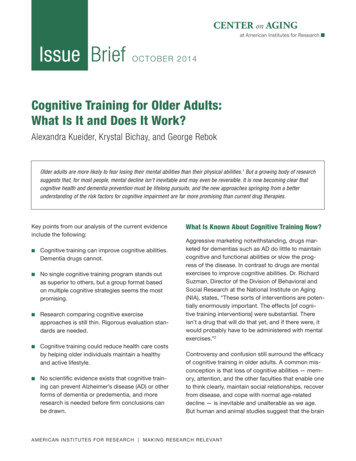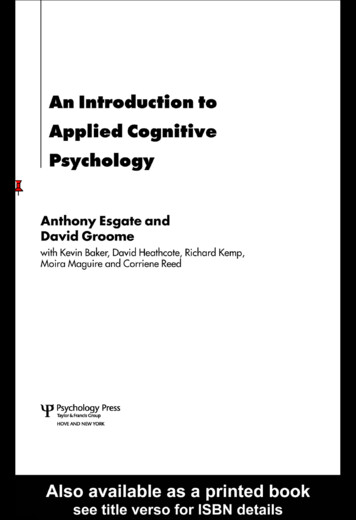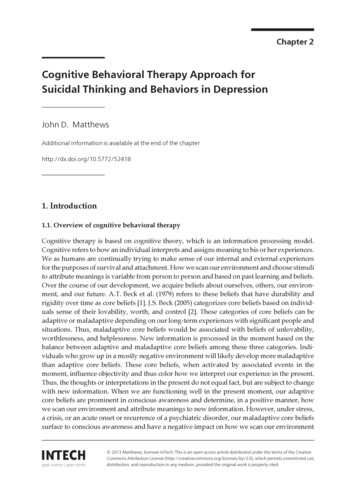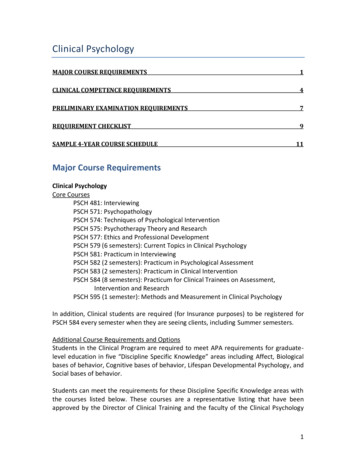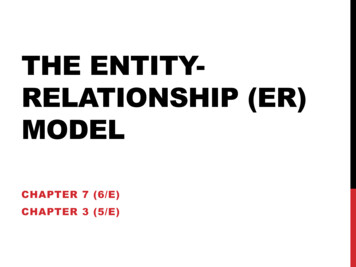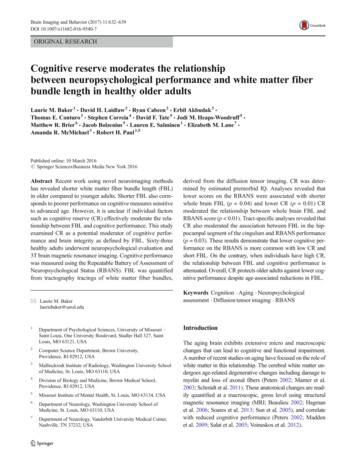
Transcription
Brain Imaging and Behavior (2017) 11:632–639DOI 10.1007/s11682-016-9540-7ORIGINAL RESEARCHCognitive reserve moderates the relationshipbetween neuropsychological performance and white matter fiberbundle length in healthy older adultsLaurie M. Baker 1 & David H. Laidlaw 2 & Ryan Cabeen 2 & Erbil Akbudak 3 &Thomas E. Conturo 3 & Stephen Correia 4 & David F. Tate 5 & Jodi M. Heaps-Woodruff 5 &Matthew R. Brier 6 & Jacob Bolzenius 5 & Lauren E. Salminen 1 & Elizabeth M. Lane 7 &Amanda R. McMichael 3 & Robert H. Paul 1,5Published online: 10 March 2016# Springer Science Business Media New York 2016Abstract Recent work using novel neuroimaging methodshas revealed shorter white matter fiber bundle length (FBL)in older compared to younger adults. Shorter FBL also corresponds to poorer performance on cognitive measures sensitiveto advanced age. However, it is unclear if individual factorssuch as cognitive reserve (CR) effectively moderate the relationship between FBL and cognitive performance. This studyexamined CR as a potential moderator of cognitive performance and brain integrity as defined by FBL. Sixty-threehealthy adults underwent neuropsychological evaluation and3T brain magnetic resonance imaging. Cognitive performancewas measured using the Repeatable Battery of Assessment ofNeuropsychological Status (RBANS). FBL was quantifiedfrom tractography tracings of white matter fiber bundles,* Laurie M. Bakerlauriebaker@umsl.edu1Department of Psychological Sciences, University of Missouri –Saint Louis, One University Boulevard, Stadler Hall 327, SaintLouis, MO 63121, USA2Computer Science Department, Brown University,Providence, RI 02912, USA3Mallinckrodt Institute of Radiology, Washington University Schoolof Medicine, St. Louis, MO 63110, USA4Division of Biology and Medicine, Brown Medical School,Providence, RI 02912, USA5Missouri Institute of Mental Health, St. Louis, MO 63134, USA6Department of Neurology, Washington University School ofMedicine, St. Louis, MO 63110, USA7Department of Neurology, Vanderbilt University Medical Center,Nashville, TN 37232, USAderived from the diffusion tensor imaging. CR was determined by estimated premorbid IQ. Analyses revealed thatlower scores on the RBANS were associated with shorterwhole brain FBL (p 0.04) and lower CR (p 0.01) CRmoderated the relationship between whole brain FBL andRBANS score (p 0.01). Tract-specific analyses revealed thatCR also moderated the association between FBL in the hippocampal segment of the cingulum and RBANS performance(p 0.03). These results demonstrate that lower cognitive performance on the RBANS is more common with low CR andshort FBL. On the contrary, when individuals have high CR,the relationship between FBL and cognitive performance isattenuated. Overall, CR protects older adults against lower cognitive performance despite age-associated reductions in FBL.Keywords Cognition . Aging . Neuropsychologicalassessment . Diffusion tensor imaging . RBANSIntroductionThe aging brain exhibits extensive micro and macroscopicchanges that can lead to cognitive and functional impairment.A number of recent studies on aging have focused on the role ofwhite matter in this relationship. The cerebral white matter undergoes age-related degenerative changes including damage tomyelin and loss of axonal fibers (Peters 2002; Marner et al.2003; Schmidt et al. 2011). These anatomical changes are readily quantified at a macroscopic, gross level using structuralmagnetic resonance imaging (MRI; Beaulieu 2002; Hagmanet al. 2006; Soares et al. 2013; Sun et al. 2005), and correlatewith reduced cognitive performance (Peters 2002; Maddenet al. 2009; Salat et al. 2005; Voineskos et al. 2012).
Brain Imaging and Behavior (2017) 11:632–639Diffusion tensor imaging (DTI) provides an ideal methodto study white matter integrity (Filippi et al. 2001; Jeong et al.2011) at a microstructural level. Many DTI studies utilizescalar metrics, such as fractional anisotropy (FA) and meandiffusivity (MD) to characterize water diffusion within a voxel. The values of these and other scalar metrics in each imagevoxel reflect the speed of water diffusion and the extent towhich it is directionally restricted by the microstructural anatomy of the underlying tissue. DTI tractography can be used tomeasure the orientation of white matter fiber bundlesreflecting neuronal fiber pathways (Conturo et al. 1999;Mori et al. 1999).More recently, quantitative tractography based on DTI(qtDTI) has been developed to assess cerebral white matterintegrity using both scalar metrics and tractography. qtDTImetrics such as fiber bundle length (FBL) are effective indetecting tract specific alterations that may be distributed anywhere along the tractography model (Correia et al. 2008).FBL represents the length of coherent bundles of nerve fibersand can be used to detect specific diffusivity properties along afiber bundle. This method is sensitive to to reductions in whitematter microstructural integrity (Correia et al. 2008). ShorterFBL is believed to reflect axonal loss with possible contributions from demyelination, gliosis, or other pathological processes that commonly occur in older adults (Correia et al.2008).Previous studies utilizing qtDTI have observed significantnegative associations between age and FBL in healthy olderindividuals (Baker et al. 2014; Bolzenius et al. 2013;Salminen et al. 2013). These findings are consistent with postmortem data demonstrating reduced fiber lengths with advanced age (Marner et al. 2003; Tang et al. 1997). A priorstudy also revealed a significant relationship between FBLand cognitive performance in healthy adults over the age of50 (Behrman-Lay et al. 2014). However, it is unclear whetherindividual factors protect against lower cognitive function inthe context of reduced FBL in older adults.Prior studies have identified important variables that moderate the relationship between neuroimaging abnormalitiesand neurocognitive performance, with a particular focus oncognitive reserve (CR; Kesler et al. 2003; Sánchez et al.2002; Satz 1993; Lane et al. 2011; Sawrie et al. 2000; Sternet al. 1996). CR theory has been proposed to explain the discrepancy between individuals with similar degrees of neuropathology, but with varying levels of cognitive performance(Stern 2002). The role of CR has been widely studied in relation to neuropsychological manifestations of subcortical whitematter hyperintensities (WMH) defined as T2 hyperintensemarkers and believed to represent vascular dysfunction inhealthy older adults (Brickman et al. 2011; Dufouil et al.2003; Nebes et al. 2006; Murray et al. 2011). Studies havereported that CR moderates the relationship between subcortical WMH and cognition in older individuals (Brickman et al.6332011; Dufouil et al. 2003; Nebes et al. 2006; Lane et al. 2011;Murray et al. 2011). Yet, little research has focused on theimpact of CR on the relationship between cognition and themicrostructural integrity of cerebral white matter independentof WMH in healthy adults (Arenaza-Urquijo et al. 2011).Importantly, no studies have examined the impact of CR onthe relationship between cognition and FBL. This is an important gap in the literature as aging exerts both vascular andnonvascular effects on the brain.The purpose of the current study was to investigate therelationships between CR, FBL, and cognitive performancein a sample of healthy adults over age 50. Specifically, weexamined whether CR moderated the relationship betweenFBL and cognitive performance. We hypothesized individuals with higher CR would demonstrate better cognitiveperformance despite similar whole brain FBL, comparedto individuals with lower CR. As a secondary aim, we evaluated the relationships between CR, cognitive performance, and FBL in specific white matter association tractsincluding the cingulate gyrus segment of the cingulum(CGC), hippocampal segment of the cingulum (CGH), inferior fronto-occipital fasiculus (IFOF), and uncinatefasiculus (UF). Premorbid IQ (using the Wide RangeAchievement Test-4- reading subtest; WRAT-4) was usedas our measure of CR.MethodsParticipantsSixty-three individuals enrolled in a study of healthy cognitiveaging were included in the present study. Participants wererecruited from the local community using print, radio, anddirect outreach. Participants were also recruited from theResearch Participant Registry of the Washington UniversityInstitute of Clinical and Translational Sciences (ICTS).The study was approved by the affiliated InstitutionalReview Board and all participants provided informed consent. Data included in this manuscript were obtained incompliance with the Helsinki Declaration. Participantswere required to be English speaking and over the age of50. Exclusion criteria consisted of a history of neurologicaldisease including dementia, stroke, Parkinson’s disease, orother conditions that could impact mental status.Participants with diabetes requiring treatment, head injurywith loss of consciousness greater than 5 min, alcohol ordrug abuse, or a significant Axis I or II psychiatric condition (e.g., schizophrenia, bipolar disorder, current severedepression) were also excluded. Individuals with scoresbelow 24 on the Mini-Mental State Examination were excluded. A physician evaluated all imaging scans to excludeindividuals with gross radiological abnormalities.
634Neuroimaging acquisitionMRI acquisitions were obtained using a head-only MagnetomAllegra 3T MRI scanner at Washington University in St.Louis. The scanner is optimized for head imaging, withhigh-performance head-only gradients capable of 400 T/m/sslew rate, and 40 mT/m gradient strength on each axis simultaneously, with 100 % duty cycle. The gradients enable rapidechoplanar readout and efficient diffusion encoding with relatively short echo time (TE) and scan time, without signal-tonoise (SNR) tradeoffs (e.g., parallel imaging). Quality assurance was conducted daily to ensure data fidelity. Movementwas limited by application of surgical tape across the forehead, and headphones that closely fit in head coil. Each scanning session began with a scout scan consisting of three orthogonal planes to confirm head positioning. For quality assurance, identical pulse sequences and movement minimization tactics (e.g., tape across the forehead) were used throughout the course of the study. Automated high-order shimmingwas utilized.Structural MRI acquisitionsWhole brain structural scans were obtained using a T1weighted magnetization-prepared rapid-acquisition gradientecho (MP-RAGE) sequence (Mugler and Brookeman 1990);a double-echo proton-density (PD)/T2-weighted turbo spinecho (TSE) sequence; and a T2-weighted fluid-attenuatedinversion-recovery (FLAIR) TSE sequence (Hajnal et al.1992).Diffusion-Weighted Imaging (DWI) acquisitionAxial DWI was acquired using a customized single-shotmultislice echo-planar tensor-encoded pulse sequence designed and implemented in-house. Thirty-one non- collinear diffusion-encoded directions were used in the acquisition consisting of 24 main directions (diffusion weightingof b 996 s/mm2) (Conturo et al. 1996). Additionally, weused a Bcore of tetrahedral- perpendicular directions(b 1412 and 680 s/mm2, respectively) and 5 I0 acquisitions (b 0) for wide directional coverage and signal-tonoise (SNR) efficiency to cancel eddy-current effects.Pulse sequence and acquisition parameters were optimizedfor tractography, and attention was paid to high SNR toprevent track foreshortening (Lori et al. 2002). The TEwas 86.2 ms with full-Fourier acquisition (maximizingSNR and minimizing artifact). In a TR of 7.82 s, 64 contiguous 2.0-mm slices were acquired for each contrast. Theacquisition matrix was 128 128 with a 256 256 mmFOV (isotropic 2.0 2.0 2.0 mm voxels). Signal averaging (72 total acquisitions) was acquired over two scanrepeats, and all unedited data were included in theBrain Imaging and Behavior (2017) 11:632–639analyses. Raw data were saved to the operating systemdisk, and floating-point DWI images were custom reconstructed using a SunFire V880 computer server.Quantitative diffusion tractographyEach individual’s DWI images and b-vectors were registeredto the I0 image using FSL’s FLIRT (mutual information metric) (Jenkinson et al. 2002) to correct for subject motion. Braintissue was extracted with FSL’s Brain Extract Tool (Smith2002). Tensors and fractional anisotropy (FA) values werereconstructed using linear least squares fitting. Whole braintractography was obtained by streamline integration with trilinear interpolation of the DWI and linear least squares fittingof the diffusion tensor. Tracking was performed with thetensors’s principal eigenvector with the following parameters:one random seed per voxel, second-order Runge-Kutta integration, an angle threshold of 35 degrees, an FA threshold of0.15, and a minimum-length threshold of 10 mm.FA images were registered with the Johns HopkinsUniversity (JHU) white matter atlas using affine registrationand FSL FLIRT to examine anatomical features of specifictracts. Tracts including the CGC, CGH, IFOF, and UF wereselected due to previously established associations with globalcognition (Baek et al. 2013; Booth et al. 2013; Cremers et al.2016). Each tract was modeled separately by hemisphere andstreamlines were selected for inclusion in each bundle usingthe JHU atlas regions-of-interest. Fibers were included in thebundle if at least 80 % of the arc length was contained in thebundle mask, and streamlines were culled within 0.8 mm of anexisting tract were used to reduce redundancy (Zhang et al.2003). FBL was computed from the total length of the streamlines included in the bundle. Eight participants failed processing during tract-specific analysis and therefore were only included in the whole brain analysis. FBL was normalized bydividing by total intracranial volume (Correia et al. 2008).Repeatable Battery for the Assessmentof Neuropsychological Status (RBANS)The RBANS (Randolph 1998) yields five scores including:(1) Immediate Memory-learning verbal information (2)Language- confrontation naming and semantic fluency (3)Visuospatial/Construction- construction of a complex figureand judgment of line orientation (4) Attention- digit span andcoding (5) Delayed Memory- recall of verbal learning tasksand complex figure after delay. Raw subtest scores are scaledfor each cognitive domain to create index scores. The outcomemeasures for each subtest are converted to an index scorebased on standardized performance scores by age. Indexscores are combined to create an overall standard score witha mean of 100 and standard deviation of 15. Higher scoresindicate better cognitive functioning.
Brain Imaging and Behavior (2017) 11:632–639Wide Range Achievement Test-4 (WRAT-4)The WRAT-4 (Glutting and Wilkinson 2005) reading subtestscore provides a measure of reading achievement andpremorbid IQ. Participants read aloud a list of 55 words thatincrease in complexity throughout the task, and one point isawarded for each correctly pronounced word. Total wordscorrectly pronounced serves as the outcome measure and wereconverted to age adjusted standard scores. Standard scoreswith a mean of 100 and standard deviation of 15 were reported. The WRAT-4 standardized score served as the CR variablein the analyses. Previous studies have successfully utilizedpremorbid IQ as a measure of CR (Bleecker et al. 2007;Brickman et al. 2011; Foley et al. 2012).Statistical analysesPrimary anlaysesAll statistical analyses were conducted using R version 2.14.0.Demographic information is listed in Table 1. An independentsamples t-test was utilized to determine potential differencesin whole brain FBL, RBANS score, and/or CR between malesand females. Males had significantly longer FBL (t 2.52,p 0.01), therefore sex was included as a covariate in theprimary regression models. No other differences were notedbetween males and females. Two multiple regressions (main635effects and interaction) were completed to determine the relationship between total RBANS score and whole brain FBL,and whether the relationship was moderated by Cr. Prior toregression analyses, whole brain FBL and CR were meancentered to reduce multicollinearity (Aiken et al. 1991). Inthe main effects regression model, total RBANS score wasregressed onto the mean-centered whole brain FBL and themean-centered CR variable. An interaction term (FBL*CR)was then added to the regression as a moderator in a secondmodel to determine if the relationship between whole brainFBL and total RBANS score was dependent on the level ofCR. An analysis of variance (ANOVA) was utilized to determine the relationship between the two regression models(Chambers 1992). Individuals were then separated into groupsbased on low ( 1 SD below the mean; low CR group), moderate ( 1 SD CR 1 SD away from mean; moderate CRgroup), and high levels of CR ( 1 SD above the mean; highCR group) for display purposes. These cut-offs are arbitraryand sample dependent, but this method of illustrating the effects is well documented (Aiken et al. 1991; Cohen et al.2003). General linear models were completed to examine thesimple slopes for each CR group.Secondary analysesSecondary analyses were conducted in a subset of participants(n 55) with FBL quantification in white matter tractsTable 1 1779239Total SampleN 63 participants (20 males, 43 females)Age (years)Education (years)aWRAT-4 Standard ScoreRBANS Standard ScoreWhole Brain FBL (mm) sumSample with tract specific FBLN 55 participants (16 males, 39 females)Age (years)Education (years)aWRAT-4 Standard ScoreRBANS Standard ScoreCingulate gyrus segment of cingulum FBL (mm) sumHippocampal segment of cingulum FBL (mm) sumInferior fronto-occipital fasciculus FBL (mm) sumUncinate fasciculus FBL (mm) sumDefinitions: RBANS Repeatable Battery for the Assessment of Neuropsychological Status, WRAT-4 Wide RangeAchievement Test-4, FBL Fiber bundle length, SD standard deviationaThe years of education was determined by the highest level of education completed, in years. Continuingeducation, trade school credits, and additional degrees at the same level (i.e., two bachelor’s degrees) were notcounted toward the final number of education years
636Brain Imaging and Behavior (2017) 11:632–63911010090RBANS Standard Score120130The Effect of CR on the Association of RBANS and FBL80(Table 1). Four independent samples t-tests were utilized todetermine potential sex differences in specific white mattertract FBL (CGC, CGH, IFOF, UF) and RBANS performance.Males had significantly longer FBL in the CGC (t 4.20,p 0.01) therefore, sex was included as a covariate in theregression models examining the relationships between theCGC, RBANS, and CR. However, there were no differencesin FBL between males and females in other white matter tracts(ps 0.05). The same analytic process from the primary analyses was uiltized to address the tract-specific y analysesPrimary analyses examined the impact of whole brain FBL andCR on RBANS performance. The main effects regression model of total RBANS score onto whole brain FBL and CR wasstatistically significant (F(3,59) 3.88; p 0.01, R2 0.16,f2 0.19), with FBL and CR accounting for 16 % of the variance in RBANS performance. Both longer whole brain FBL(t 2.13, p 0.04) and higher CR (t 2.52, p 0.01) weresignificantly related to better performance on the RBANS. Theoverall interaction (FBL*CR) was also statistically significant(F(4,58) 4.35 p 0.01, R2 0.23, f2 0.30), suggesting thatthe effect of FBL on RBANS differed as a function of CR(simple effects and interaction values listed in Table 2). Thismodel accounted for 23 % of the variance in RBANS performance. The higher R2 (additional 11 % of the variance inRBANS performance) demonstrated that the regression thatincluded the FBL*CR interaction term was a better fit of thedata than the model without the interaction and this was confirmed by an ANOVA contrasting the two regression models(F(1,58) 4.99, p 0.03, Cohen’s d 0.56).An important point to note for this model is the form of theinteraction. Figure 1 illustrates the simple slopes for theTable 2 Summary of primary interaction regression analysis for themoderating effects of CR on whole brain FBL and RBANS scoresVariableEstimateStd. Errort valuep valueInterceptSexFBLCRFBL*CR1.04e 02 1.39 001.42e–054.26e–011.65e–065.39e 003.10e 007.54e–061.45e–017.36e–0719.32 0.451.892.94 2.24 2e–160.6550.0640.005**0.029*N 63. FBL is mean-centered. CR is mean-centered. FBL*CR is the interaction of mean-centered FBL and mean-centered CRDefintions: FBL Fiber bundle length, CR Cognitive Reserve*p . 05**p .011200000FBL (mm)14000001600000Fig. 1 The effect of CR in the association of RBANS and FBL. LowCognitive Reserve: solid line ( 1 SD below the mean) ModerateCognitive Reserve: dotted line ( 1 SD CR 1 SD from the mean)High Cognitive Reserve: dashed line ( 1 SD above the mean)Definitions: RBANS Repeatable Battery for the Assessment ofNeuropsychological Status, FBL Fiber Bundle Length, CR CognitiveReserverelationship between RBANS with varying levels of CR.Furthermore, results of the simple slope analyses (Table 3)revealed that individuals with the lowest CR demonstrated astrong positive relationship between RBANS and whole brainFBL (t 3.25, p 0.01). That is, when individuals with lowerCR have shorter FBL, they are more likely to demonstratelower cognitive performance on the RBANS. On the contrary,when individuals have moderate (t 1.23, p 0.22) or highCR (t 0.78, p 0.48), the relationship between FBL andRBANS scores is attenuated.Secondary analysesThe main effects regression model of total RBANS score ontothe CGH and CR demonstrated that FBL in the CGH predicted RBANS performance at a trend level F(2,52) 2.64;p 0.08, R2 0.09, f2 0.09, accounting for 9 % of thevariance in RBANS performance. Results indicated thathigher CR was associated with better RBANS performanceat a trend level (t 1.77, p 0.08). However, longer FBL wasnot significantly associated with better RBANS performancein the CGH (t 1.00, p 0.32). The regression with an interaction included (CGH FBL*CR) was significant (F(3,51) 3.13 p 0.03, R2 0.16, f2 0.19), accounting for16 % of the variance in RBANS performance. The higheradjusted R2 in the interaction model demonstrated that theregression that included the interaction term was a better fitof the data and this was confirmed by an ANOVA (F(1,51) 3.82, p 0.06, Cohen’s d 0.53). There were no significant main effects or interactions observed in the CGC,IFOF, UF regression models (p’s 0.05).
Brain Imaging and Behavior (2017) 11:632–639Table 3 Simple slope analysesfor CR groupsVariable637EstimateStd. Errort valuep value95 % CICoefficientLow CR4.29e-051.32e-053.250.01*1.30e-05, 7.28e-054.29e-05Moderate CR1.09e-058.80e-061.2330.226.88e-06, 2.86e-051.09e-05High CR 1.96e-052.51e-05 0.780.48 8.92e-05, 5.01e-05 1.95e-05N 63. FBL is mean-centered. FBL*CR is the interaction of mean-centered FBL and trichotomized CR groupsDefinitions: CR Cognitive Reserve, CI Confidence Interval*p 0.05DiscussionIn the present study we examined the impact of CR, asestimated by premorbid IQ, on cognition and FBL inhealthy older adults. Neuropsychological assessment andneuroimaging were utilized to examine the relationship between cognitive performance and FBL in healthy olderadults over the age of 50. Results of the present study confirm prior findings that longer FBL is associated with bettercognitive performance (Behrman-Lay et al. 2014). Currentfindings also demonstrate a positive relationship betweencognitive performance and FBL in the CGH. Importantly,these data suggest that CR moderates the relationship between cognition and whole brain FBL. CR also moderatesthe relationship between cognition and FBL in the CGH.Our study revealed that FBL and cognitive relationshipswere pronounced among individuals with lower CR, whileindividuals with higher CR show a more attenuated relationship between cognition and FBL. Specifically, individuals with higher levels of CR had less cognitive impact dueto shorter FBL, suggesting that they are better protectedagainst reduced cognitive performance associated withshorter FBL. In contrast, individuals with lower CR hadsignificantly lower cognitive performance with shorterFBL.Relationships between CR and cognitive aging havebeen well documented. Engagement in mentally stimulating activities protects against cognitive decline due to aging and disease by promoting synaptic growth early in life(Kesler et al. 2003; Mortimer et al. 2003). The enhancement of neural connections creates efficient cognitive processes that withstand neuropathology and/or the early establishment of these connections may enable an individualto complete a cognitive task by utilizing alternative cognitive processes (Stern 2009). It is also possible that individuals with higher CR engage in more cognitively stimulating activities throughout the lifetime (e.g., occupational attainment, social engagement, or physical activity),which may then lead to promotion of compensatory brainmechanisms.Conclusions regarding the relationship between CR, FBL,and cognitive performance should be tempered by severallimitations of the current study. First, prior research hasutilized variables other than premorbid IQ as a proxy of CR,therefore this variable may not be inclusive of all factors thatcould potentially influence CR. While examination of a variety of factors may provide a more comprehensive understanding of the role of CR on cognition and presumed nonvascularwhite matter changes with age, premorbid IQ has been widelyused as a proxy of reserve in previous studies for severalreasons. Specifically, it has been suggested that IQ may reflectcognitive skills acquired in early childhood leading to increased neuronal connections (Stern 2002). Although education level has been widely used in studies of CR, an advantageof using estimated premorbid IQ (i.e., WRAT-4 reading subtest) as a moderator is that this proxy indicator of CR is associated with broader life experiences than formal education.Lastly, the current study is limited in the assessment of executive function. However, we successfully identified relationships between whole brain and tract specific imaging withcognition measured with the RBANS, suggesting sufficientsensitivity of the cognitive battery. Nevertheless, future studies examining the moderation of CR on neuropsychologicalperformance and FBL utilizing a broader range of cognitivetests are warranted, particularly since individual cognitive domains may provide additional understanding of the relationships between CR and neuropsychological performance. Suchanalyses could also be utilized to assess the relationships between cognitive performance and individual tract integrity toprovide specificity to the relationships between FBL, cognitive performance, and CR.Overall the results of the present study confirm a positiveassociation between whole brain and tract specific FBL andcognitive performance in older adults. Further, findingssuggest that individuals with a higher CR are able to sustaingreater amounts of white matter alterations than individualswith lower CR. These results support the role of the CR inthe protection against lower cognitive performance in thecontext of reduced white matter integrity among olderadults.Funding Supported by National Institutes of Health/National Instituteof Neurological Disorders and Stroke grant number R01 NS052470 andR01 NS039538, National Institutes of Health/National Institute of MentalHealth grant R21 MH090494 and R21 MH105822. Recruitment databasesearches were supported in part by National Institutes of Health/NationalCenter for Research Resources grant UL1 TR000448.
638Compliance with ethical standardsConflict of interest Laurie M Baker, David H Laidlaw, Ryan Cabeen,Erbil Akbudak, Thomas E Conturo, Stephen Correria, David F Tate, JodiM Heaps-Woodruff, Matthew R Brier, Jacob Bolzenius, Lauren ESalminen, Elizabeth M Lane, Amanda R McMichael, and Robert HPaul declare no conflicts of interest.Informed consent All procedures followed were in accordance withthe ethnical standards of the responsible committee on human experimentation (institutional and national) and with the Helsinksi Declaration of1975, and the applicable revisions at the time of the investigation.Informed consent was obtained from all patients for being included inthe study.ReferencesAiken, L. S., West, S. G., & Reno, R. R. (1991). Multiple regression:Testing and interpreting interactions. Sage.Arenaza-Urquijo, E. M., Bosch, B., Sala-Llonch, R., Solé-Padullés,C., Junqué, C., Fernández-Espejo, D., & Bartrés-Faz, D.(2011). Specific anatomic associations between white matterintegrity and cognitive reserve in normal and cognitively impaired elders. The American Journal of Geriatric Psychiatry,19(1), 33–42.Baek, S. O., Kim, O. L., Kim, S. H., Kim, M. S., Son, S. M., Cho, Y. W.,& Jang, S. H. (2013). Relation between cingulum injury and cognition in chronic patients with traumatic brain injury; diffusion tensortractography study. NeuroRehabilitation, 33(3), 465–471.Baker, L. M., Laidlaw, D. H., Conturo, T. E., Hogan, J., Zhao, Y., Luo, X.,& Paul, R. H. (2014). Impact of advanced age on fiber bundlelengths utilizing diffusion MRI in white matter tracts. Neurology,83(3), 247–252.Beaulieu, C. (2002). The basis of anisotropic water diffusion in the nervous system–a technical review. NMR in Biomedicine, 15(7–8),435–455.Behrman-Lay, A. M., Usher, C., Conturo, T. E., Correi
lauriebaker@umsl.edu 1 Department of Psychological Sciences, University of Missouri - Saint Louis, One University Boulevard, Stadler Hall 327, Saint Louis, MO 63121, USA 2 Computer Science Department, Brown University, Providence, RI 02912, USA 3 Mallinckrodt Institute of Radiology, Washington University School of Medicine, St. Louis, MO .



